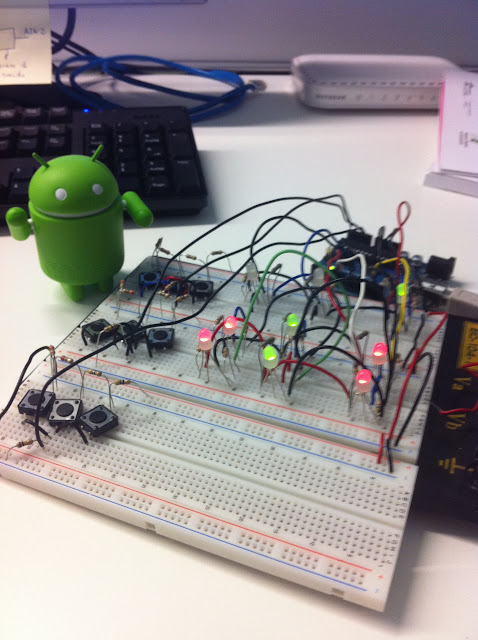Watch live streaming video from 3astest at livestream.com
androino
Connect your mobile to the real world objects
Interfacing android and arduino through an audio connection.
Thursday, 29 March 2012
Androino project explained (spanish)
The whole project explained in 20 minutes.
Wednesday, 28 March 2012
Tuesday, 13 March 2012
Androino Terminal Beta 1.0 Release
Finally the project reached the beta stage. We have implemented a simple terminal application that communicates an android phone with an arduino board using the audio channel. The current implementation allows sending and receiving integers (between 1 and 31).
The source code and the developer documentation is available at the Google code Androino project http://code.google.com/p/androino/
The wiki page contains the instructions to run the app and the source code (both android and arduino) is available for download here.
The source code and the developer documentation is available at the Google code Androino project http://code.google.com/p/androino/
The wiki page contains the instructions to run the app and the source code (both android and arduino) is available for download here.
Monday, 16 January 2012
Time to report
Once the project is finish, is time to collect all the information.
One importat part of the report is to explain how the code works. Is important to define all the classes and all the information flow between them, the most clearly way to describe this is using sequence diagrams.
The reason I'm writting this post is because I found an interesting Java program which creates this sequence diagram from your source code.
This program is eUML2,
eUML2 for Java is a powerful UML modeler designed for Java developer in Eclipse. The main features are:
Website: http://www.soyatec.com/euml2/
One importat part of the report is to explain how the code works. Is important to define all the classes and all the information flow between them, the most clearly way to describe this is using sequence diagrams.
The reason I'm writting this post is because I found an interesting Java program which creates this sequence diagram from your source code.
This program is eUML2,
eUML2 for Java is a powerful UML modeler designed for Java developer in Eclipse. The main features are:
- Real-time code/model synchronization
- Advanced reversed engineering
- Powerful true dependency analyze tools
- JDK 1.4 and 1.5 support
- Customizable template support.
Website: http://www.soyatec.com/euml2/
Saturday, 10 December 2011
Bidirectional communication implemented
The prototype implementation is completed. The system can communicate android with arduino in both directions. This poor quality video show the prototype sending and receiving a message.
Source code will be published soon.
Source code will be published soon.
Thursday, 3 November 2011
Tuesday, 27 September 2011
Finally it worked!
Finally I could establish Serial Communication using audio between Arduino and an Android device. This can be done thanks to the FSK modulation, when the data '0 'is a low frequency carrier, when the data '1' will send a high-frequency carrier.
The communication is biderectional, it can go from the Arduino to the Android device and vice versa. When you start the application, it is ready to be sent and received in ASCII mode. The data received is stored in a buffer and then will appear on the screen, there is no real-time display.
After stablishing the communication in both ways, I decided to obtain real data from real world, so I decided to measure the temperature of my workroom.
I connected a thermistor to one of the Analog input pin in the arduino and using the data it obtains I am able to read them in my Andorid device through the audio port. The speed of communication I get is around 315 bps, it is not to much, but for the moment it is enough for the data I'm testing. In a future I will try to increase the amount of data I can send.


The communication is biderectional, it can go from the Arduino to the Android device and vice versa. When you start the application, it is ready to be sent and received in ASCII mode. The data received is stored in a buffer and then will appear on the screen, there is no real-time display.
After stablishing the communication in both ways, I decided to obtain real data from real world, so I decided to measure the temperature of my workroom.
I connected a thermistor to one of the Analog input pin in the arduino and using the data it obtains I am able to read them in my Andorid device through the audio port. The speed of communication I get is around 315 bps, it is not to much, but for the moment it is enough for the data I'm testing. In a future I will try to increase the amount of data I can send.


Subscribe to:
Comments (Atom)

